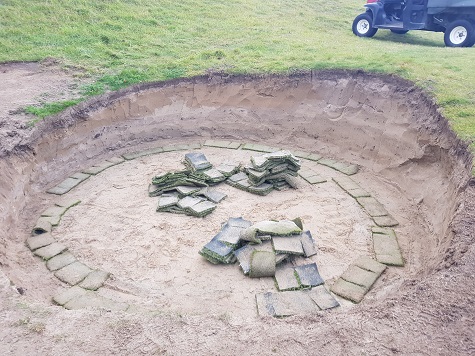The Island GC outside Dublin, generally regarded as one of Ireland’s finest courses, has rebuilt a large proportion of its revetted bunkers using a new solution from synthetic bunker solutions provider EcoBunker.
The course, which is currently undergoing a renovation at the hands of architects Mackenzie and Ebert, has adopted a new approached created by EcoBunker inventor and CEO Richard Allen, that sees the bottom six turf layers of the revetted wall built from synthetic turf, while the rest is natural.

“Revetted bunkers decay from the bottom up, which is only to be expected because it is the bottom of the wall that is most exposed to water,” says Allen. “When the bottom of the wall fails, wind and rain get in behind the revet and remove sand, eventually causing the wall to collapse. With synthetic turf at the base, this will not happen, and the longevity of the wall will be significantly enhanced.”
“Setting the base of a revetted bunker is the part of the build that takes the most time,” says course manager Dave Edmondson. “With the EcoBunker base in place, all we will have to do when it comes to rebuilding the wall is to remove the natural revet with a spade and replace the turf. Six layers of artificial turf is a totally solid base on which to build the rest of the wall. It’s not going to move. Our revetted bunkers normally last between three and five years – south facing ones degrade faster than others – so the improvement using this EcoBunker method could be quite substantial.”
Edmondson says it is hard to see a downside of this new method. “We have to buy in my revetting turf, so putting in a synthetic base will actually make rebuilding cheaper in the future,” he explains. “And there is absolutely zero aesthetic impact. When the sand is ready for play, the synthetic turf is all below the sand line. Everything you can see is natural; it looks just like a normal revetted bunker.”